It takes energy to accomplish any of the activities that we associate with GDP. It takes energy to grow food: human energy, solar energy, and–in today’s world–the many types of energy used to build and power tractors, transport food to markets, and provide cooling for food that needs to be refrigerated. It takes energy to cook food and to smelt metals. It takes energy to heat and air condition offices and to power the internet. Without adequate energy, the world economy would come to a halt.
We are hitting energy limits right now. Energy per capita is already shrinking, and it seems likely to shrink further in the future. Reaching a limit produces a conflict problem similar to the one in the game musical chairs. This game begins with an equal number of players and chairs. At the start of each round, a chair is removed. The players must then compete for the remaining chairs, and the player who ends the round without a chair is eliminated. There is conflict among players as they fight to obtain one of the available chairs. The conflict within the energy system is somewhat hidden, but the result is similar.
A current conflict is, “How much energy can we spare to fight COVID-19?” It is obvious that expenditures on masks and vaccines have an impact on the economy. It is less obvious that a cutback in airline flights or in restaurant meals to fight COVID-19 indirectly leads to less energy being produced and consumed, worldwide. In total, the world becomes a poorer place. How is the pain of this reduction in energy consumption per capita to be shared? Is it fair that travel and restaurant workers are disproportionately affected? Worldwide, we are seeing a K shaped recovery: The rich get richer, while the poor get poorer.
A major issue is that while we can print money, we cannot print the energy supplies needed to run the economy. As energy supplies deplete, we will increasingly need to “choose our battles.” In the past, humans have been able to win many battles against nature. However, as energy per capita declines in the future, we will be able to win fewer and fewer of these battles against nature, such as our current battle with COVID-19. At some point, we may simply need to let the chips fall where they may. The world economy seems unable to accommodate 7.8 billion people, and we will have no choice but to face this issue.
In this post, I will explain some of the issues involved. At the end of the post, I include a video of a panel discussion that I was part of on the topic of “Energy Is the Economy.” The moderator of the panel discussion was Chris Martenson; the other panelists were Richard Heinberg and Art Berman.
[1] Energy consumption per person varies greatly by country.
Let’s start with a little background. There is huge variability in the quantity of energy consumed per person around the world. There is more than a 100-fold difference between the highest and lowest countries shown on Figure 1.
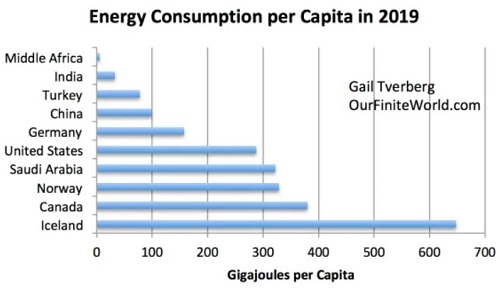
Figure 1. Energy consumption per capita in 2019 for a few sample countries based on data from BP’s 2020 Statistical Review of World Energy. Energy consumption includes fossil fuel energy, nuclear energy and renewable energy of many types. It omits energy products not traded through markets, such as locally gathered wood and animal dung. This omission tends to somewhat understate the energy consumption for countries such as India and those in Middle Africa.
|
I have shown only a few example countries, but we can see that cold countries tend to use a lot of energy, relative to their populations. Iceland, with an abundant supply of inexpensive hydroelectric and geothermal electricity, uses it to heat buildings, grow food in greenhouses, mine “bitcoins” and smelt aluminum. Norway and Canada have both oil and gas supplies, besides being producers of hydroelectricity. With abundant fuel supplies and a cold climate, both countries use a great deal of energy relative to the size of their population.
Saudi Arabia also has high energy consumption. It uses its abundant oil and gas supplies to provide air conditioning for its people. It also uses its energy products to enable the operation of businesses that provide jobs for its large population. In addition, Saudi Arabia uses taxes on the oil it produces to subsidize the purchase of imported food, which the country cannot grow locally. As with all oil and gas producers, some portion of the oil and gas produced is used in its own oil and gas operations.
In warm countries, such as those in Middle Africa and India, energy consumption tends to be very low. Most people in these countries walk for transportation or use very crowded public transport. Roads tend not to be paved. Electricity outages are frequent.
One of the few changes that can easily be made to reduce energy consumption is to move manufacturing to lower wage countries. Doing this reduces energy consumption (in the form of electricity) quite significantly. In fact, the rich nations have mostly done this, already.
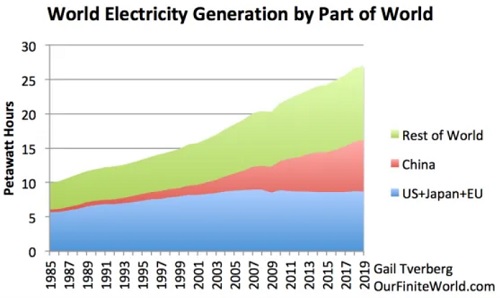
Figure 2. World electricity generation by part of the world, based on data from BP’s 2020 Statistical Review of World Energy.
|
Trying to squeeze down energy consumption for the many countries around the world will be a huge challenge because energy is involved in every part of economies.
[2] Two hundred years of history shows that very slow growth in energy consumption per capita leads to bad outcomes.
Some readers will remember that I have pieced together data from different sources to put together a reasonable approximation to world energy consumption since 1820. In Figure 3, I have added a rough estimate of the expected drop in future energy consumption that might occur if either (1) the beginning of peak fossil fuels is occurring about now because of continued low fossil fuel prices, or (2) world economies choose to leave fossil fuels and move to renewables between now and 2050 in order to try to help the environment. Thus, Figure 3 shows my estimate of the pattern of total world energy consumption over the period of 1820 to 2050, at 10-year intervals.
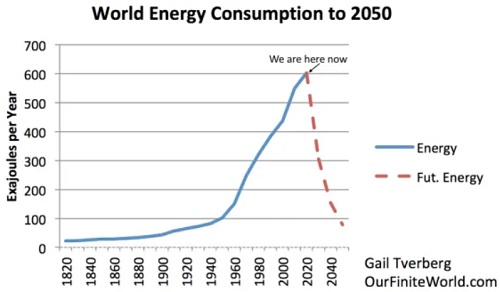
Figure 3. Estimate by Gail Tverberg of World Energy Consumption from 1820 to 2050. Amounts for earliest years based on estimates in Vaclav Smil’s book Energy Transitions: History, Requirements and Prospects and BP’s 2020 Statistical Review of World Energy for the years 1965 to 2019. Energy consumption for 2020 is estimated to be 5% below that for 2019. Energy for years after 2020 is assumed to fall by 6.6% per year, so that the amount reaches a level similar to renewables only by 2050. Amounts shown include more use of local energy products (wood and animal dung) than BP includes.
|
The shape of this curve is far different from the one most forecasters expect because they assume that prices will eventually rise high enough so all of the fossil fuels that can be technically extracted will actually be extracted. I expect that oil and other fossil fuel prices will remain too low for producers, for reasons I discuss in Section [4], below. In fact, I have written about this issue in a peer reviewed academic article, published in the journal Energy.
Figure 4 shows this same information as Figure 3, divided by population. In making this chart, I assume that population drops only half as quickly as energy consumption falls after 2020. Total world population drops to 2.8 billion by 2050.
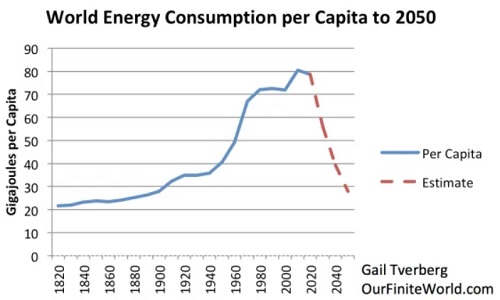
Figure 4. Amounts shown in Figure 3, divided by population estimates by Angus Maddison for earliest years and by 2019 United Nations population estimates for years to 2020. Future population estimated to be falling half as quickly as energy supply is falling.
|
In Figure 4, some parts of the curve are relatively flat, or even slightly falling, while others are rising rapidly. It turns out that rapidly rising times are much better for the economy than flat and falling times. Figure 5 shows the average annual percentage change in energy consumption per capita, for ten-year periods ending the date shown.
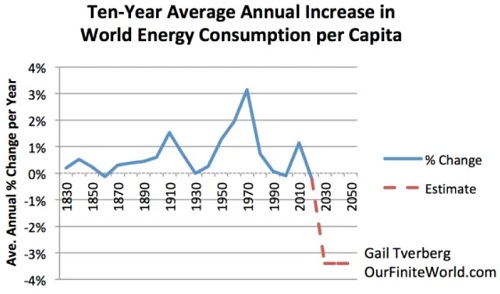
Figure 5. Average annual increase in energy consumption per capita for 10-year periods ended the dates shown, using the information in Figure 4.
|
If we look back at what happened in Figure 5, we find that when the 10-year growth in energy consumption is very low, or turns negative, conflict and bad outcomes are typical. For example:
- Dip 1: 1861-1865 US Civil War
- Dip 2: Several events
- 1914-1918 World War I
- 1918-1920 Spanish Flu Pandemic
- 1929-1933 Great Depression
- 1939-1945 World War II
- Dip 3: 1991 Collapse of the Central Government of the Soviet Union
- Dip 4: 2020 COVID-19 Pandemic and Recession
Per capita energy consumption was already growing very slowly before 2020 arrived. Energy consumption took a big step downward in 2020 (estimated at 5%) because of the shutdowns and the big cutback in air travel. One of the important things that energy consumption does is provide jobs. With severe cutbacks intended to contain COVID-19, many people in distant countries lost their jobs. Cutbacks of this magnitude quickly cause problems around the world.
For example, if people in rich countries rarely dress up to attend meetings of various kinds, there is much less of a market for dressy clothing. Many people in poor countries make their living manufacturing this type of clothing. With the loss of these sales, workers suddenly found themselves with much reduced income. Poor countries generally do not have good safety nets to provide food for those who are out of work. As a result, the diets of people subject to loss of income became inadequate, leading to greater vulnerability to disease. If the situation continues, some may even die of starvation.
[3] The pattern of world energy consumption between 2020 and 2050 (modeled in Figures 3, 4 and 5) suggests that a very concerning collapse may be ahead.
My model suggests that world energy consumption may fall to about 28 gigajoules per capita per year by 2050 (for a reduced population of 2.8 billion). This is about the level of world energy consumption per capita for the world in 1900.
Alternatively, 28 gigajoules per capita is a little lower than the per capita energy consumption for India in 2019. Of course, some parts of the world might do better than this. For example, Mexico and Brazil both had energy consumption per capita of about 60 gigajoules per capita in 2019. Some countries might be able to do this well in 2050.
Using less energy after 2020 will lead to many changes. Governments will become smaller and provide fewer services such as paved roads. Often, these governments will cover smaller areas than those of countries today. Businesses will become smaller, more local, and more involved with goods rather than services. Individual citizens will be walking more, growing their own food, and doing much less home heating and cooling.
With less energy available, it will be necessary to cut back on fighting unfortunate natural occurrences, such as forest fires, downed electricity transmission lines after hurricanes, antibiotic resistant bacteria, and constantly mutating viruses. Thus, life expectancy is likely to decline.
[4] It is “demand,” and how high energy prices can be raised, that determines how large an energy supply will be available in the future.
I keep making this point in my posts because I sense that it is poorly understood. The big problem that we should be anticipating is energy producers going out of business because energy prices are chronically too low. I see five ways in which energy prices might theoretically be raised:
- A truly booming world economy. This is what raised prices in the 1970s and in the run up to 2008. If there are truly more people who can afford homes and new vehicles, and governments that can afford new roads and other infrastructure, companies extracting oil and coal will build new facilities in higher-cost locations, and thereby expand world supply. The higher prices will help energy companies to be profitable, despite their higher costs. Such a scenario seems very unlikely, given where we are now.
- Government mandates and subsidies. Government mandates are what is maintaining demand for renewables and electric vehicles. Conversely, government mandates are part of what is keeping down tourist travel. Indirectly, this lack of demand relating to travel leads to low oil prices. A government mandate for people to engage in more travel seems unlikely.
- Much reduced wage disparity. If everyone, rich or poor, can afford nice homes, automobiles, and cell phones, commodity prices will tend to be high because buying and operating goods such as these requires the use of commodities. Governments can attempt to fix wage disparity through more printed money, but I am doubtful that this approach will really work because other countries are likely to be unwilling to accept this printed money.
- More debt, sometimes leading to collapsing debt bubbles. Spending can be enhanced if it becomes easier for citizens to buy goods such as homes and vehicles on credit. Likewise, businesses can borrow money to build new factories or, alternatively, to continue to pay wages to workers, even if there isn’t much demand for the goods and services sold. But, if the economy really is not recovering rapidly, these approaches can be expected to lead to crashes.
- Getting rid of COVID-19 inefficiencies and fearfulness. Economies around the world are being depressed to varying degrees by continued inefficiencies caused by social distancing requirements and by fearfulness. If these issues could be eliminated, it might boost economies back up to the already somewhat depressed levels of early 2020.
In summary, the issue we are facing is that oil demand (and thus prices) were far too low for oil producers because of wage disparity before the COVID-19 crisis arrived in March. Trying to get demand back up through more debt seems likely to lead to debt bubbles, which will be in danger of collapsing. There may be temporary price spikes, but a permanent fix is virtually impossible. This is why I am forecasting the severe drop in energy consumption shown in Figures 3 and 4.
[5] We humans don’t need to figure out how to fix the economy optimally between now and 2050.
The economy is a self-organizing system that will figure out on its own the optimal way of “dissipating” energy, to the extent possible. In physics terms, the economy is a dissipative structure. If the energy resource is food, energy will be dissipated by digesting the food. In the case of fossil fuel, energy will be dissipated by burning it. We may like to think that we are in charge, but we really are not. It is the laws of physics, or perhaps the Power behind the laws of physics, that is in charge.
Dissipative structures are not permanent. For example, hurricanes and tornadoes are dissipative structures. Plants and animals are dissipative structures. Eventually, new smaller economies, encompassing smaller areas of the world, may replace the existing world economy.
[6] This is a recent video of a panel discussion on “Energy Is the Economy.”
Chris Martenson is the moderator. Art Berman, Richard Heinberg and I are panelists. The Peak Prosperity folks were kind enough to provide me a copy to put up on my website.
Video of Panel Discussion “Energy Is the Economy,” created in October 2020 by Peak Prosperity. Chris Martenson (upper right) is the moderator. Richard Heinberg (upper left), Art Berman (lower left) and Gail Tverberg (lower right) are panelists.
|
ABOUT THE AUTHORS
Gail Tverberg is an actuary interested in finite world issues - oil depletion, natural gas depletion, water shortages, and climate change. Oil limits look very different from what most expect, with high prices leading to recession, and low prices leading to financial problems for oil producers and for oil exporting countries. We are really dealing with a physics problem that affects many parts of the economy at once, including wages and the financial system. She tries to look at the overall problem.
|